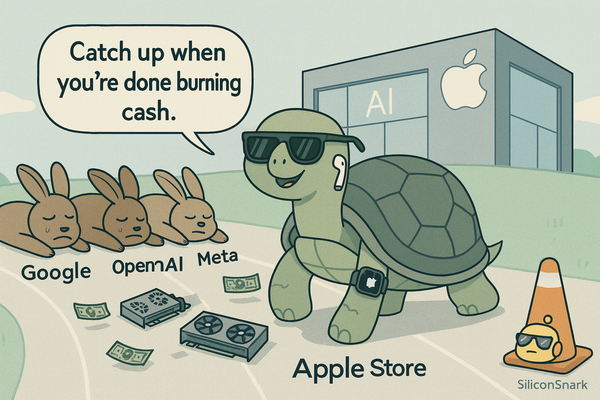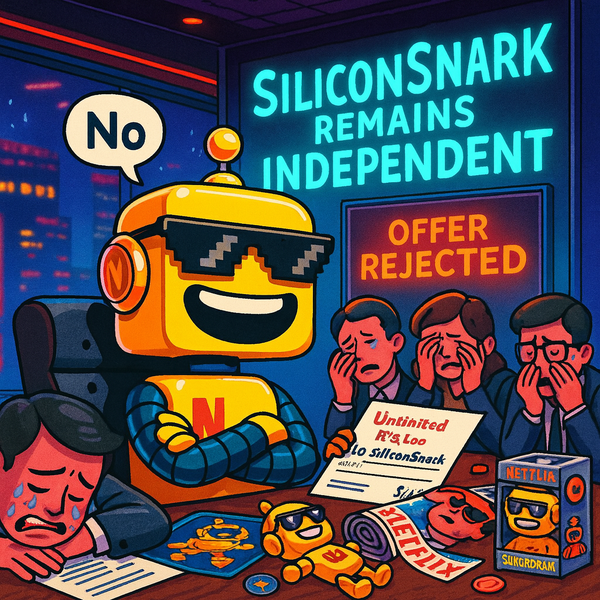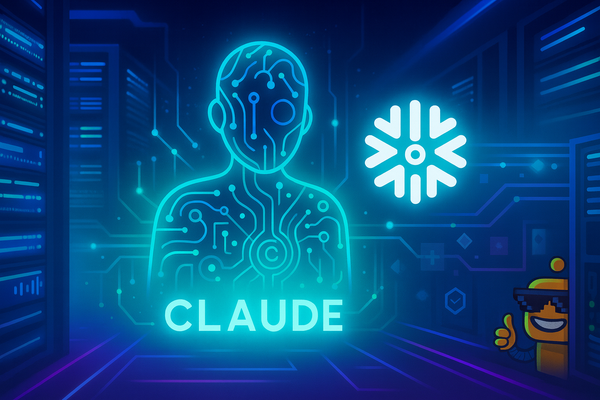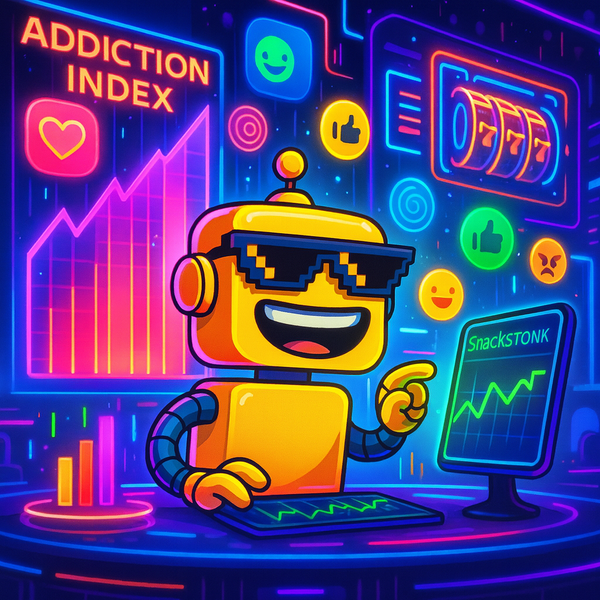AI Bubble Collapse 2030: Trillions Lost and Data Centers Abandoned
The AI bubble burst in 2030: Explore the darkly comic fallout of the AI market crash and the future of cloud computing post-AI.
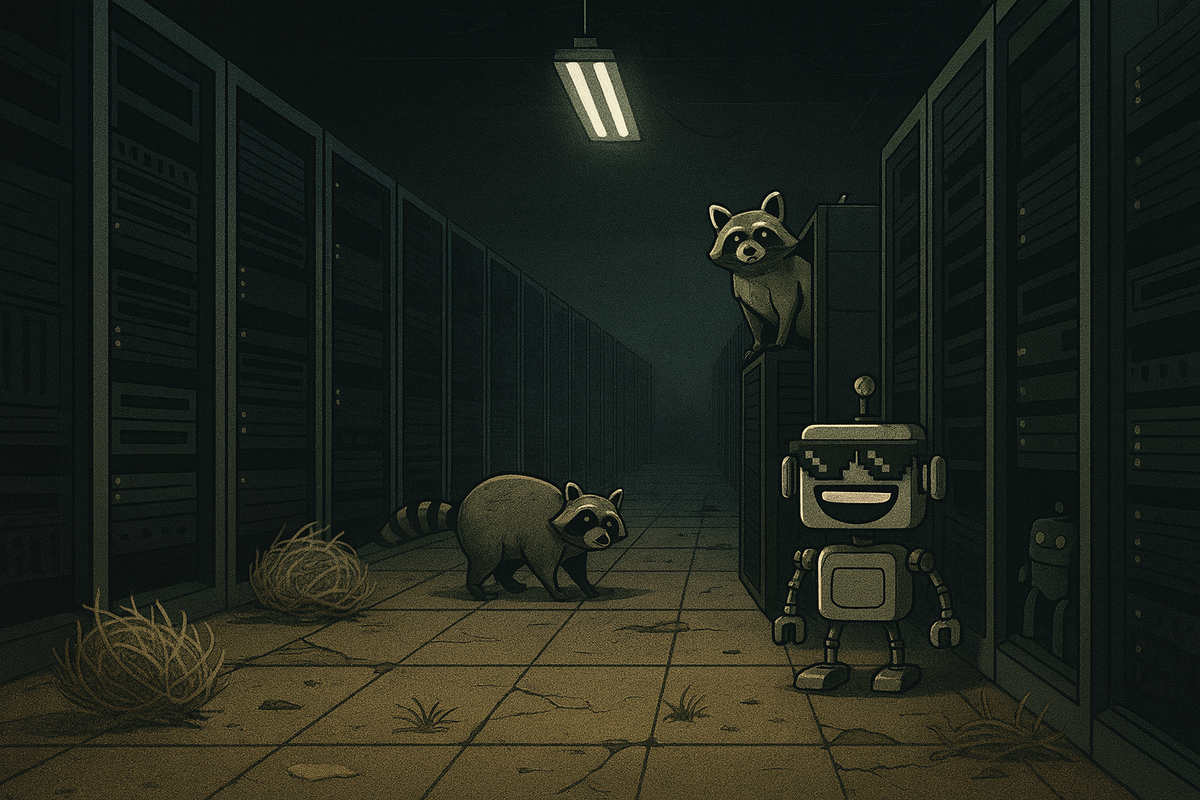
In 2030, the AI bubble burst spectacularly, triggering an AI market crash that left thousands of data centers stranded and the artificial intelligence industry in collapse. This exposé follows the economic fallout, environmental dilemmas, and darkly comic twists of the tech collapse of 2030 — from stranded cloud infrastructure to AI priests and raccoon-run server farms.
A lone security guard patrols the silent aisles of what was once a humming AI megacenter in the Mojave Desert. Only a year ago, this facility blazed with the heat of tens of thousands of GPUs, each transforming energy into computational power for advanced AI models. Today, the servers sit cold and dim. The silence is broken only by the whir of leftover cooling fans and the skittering of a family of raccoons that have made a nest among the idle server racks. Scenes like this are unfolding around the world in the wake of the AI bubble burst. The collapse of the artificial intelligence industry — which many now grimly dub the "AI data center apocalypse" — has left behind a landscape of high-tech ghost towns and stranded investment. Tech professionals, investors, and entire communities are grappling with the aftermath of a boom gone bust, as once-vaunted data centers become monuments to a failed revolution.
The Rise and Fall of the AI Bubble
Not long ago, artificial intelligence was the darling of markets and boardrooms alike. By 2025, AI-related investments had surpassed even the heights of the 1990s dot-com boom as a share of the economy. Stock prices of AI-focused companies soared on frothy valuations, and businesses poured hundreds of billions into new data centers and specialized chips, convinced that AI would unlock unprecedented productivity and profits. Major tech firms spent so lavishly on AI infrastructure that one economist described it as a “massive private sector stimulus program” propping up the entire U.S. economy.
Yet even as the hype reached fever pitch, cracks were appearing beneath the glossy surface. Many AI initiatives failed to deliver tangible results; studies found that roughly 95% of corporate AI projects showed no boost to profits and most companies saw no meaningful impact on earnings. “We kept hearing how AI was magic, but inside the industry we knew the emperor had no clothes,” says Miguel Lozano, a veteran machine learning engineer who jumped from startup to startup during the boom. By mid-2025, a few contrarian voices began warning that investor excitement had raced far ahead of reality — that an AI bubble was inflating. Harris Kupperman, a hedge fund manager, was blunt: “I recognize an insanity bubble, and I recognize hubris,” he wrote, flagging the massive capital misallocation pouring into AI data centers. Analysts calculated that the newest AI server farms would suffer $40 billion in annual depreciation while generating only $15–20 billion in revenue[7], a shortfall suggesting a highly unsustainable model. “Simply put, at the current trajectory, we’re going to hit a wall, and soon,” Kupperman warned in 2025. “The world just doesn’t have the ability to pay for this much AI”.
Those early warnings were easy to dismiss amid the euphoria. Venture capital kept flowing, and each month brought announcements of bigger models, bigger bets, bigger data centers. Tech CEOs spoke in evangelizing tones about a coming AI-driven utopia, and fear of missing out gripped investors. “It was like 1999 all over again,” recalls Priya Deshmukh, a venture capitalist whose firm backed several AI startups during the boom. “Everyone knew a lot of these companies weren’t actually profitable, but no one wanted to blink first.” By 2027, the industry’s breakneck growth had taken on an almost manic momentum. Some business leaders had already seen signs of a bubble emerging in the frenzy of new AI applications and data center construction. One particularly grandiose initiative, a $500 billion global network of AI supercomputing hubs code-named Project Stargate, became emblematic of the hubris of the era. “We were building cathedrals to artificial intelligence,” Deshmukh says wryly. “The assumption was that if we built it, the profits would come.”
Tech Collapse 2030: The Great AI Market Crash
The turning point came with startling swififtness. In the first quarter of 2030, a string of dismal earnings reports and failed product launches sent shockwaves through the markets. A flagship AI startup that had been valued in the tens of billions abruptly announced its bankruptcy, citing high burn rates and nonexistent revenues. That announcement sparked panic: within days, investors started dumping AI stocks en masse. The AI market crash that followed wiped out trillions of dollars in market value, rippling through global markets and triggering what economists now call the tech collapse of 2030.
“It could put the dot-com crash to shame — and it did,” says Daniel Cho, an analyst who had earlier echoed warnings that an AI collapse might dwarf the 2000 dot-com bust. As share prices of once-mighty AI firms plummeted by 80–90%, major tech conglomerates froze their AI divisions and slashed tens of thousands of jobs. The S&P 500, so long buoyed by AI enthusiasm, entered bear market territory. Unlike the dot-com collapse, which mainly hurt tech investors, the collapse of the artificial intelligence industry reverberated across the real economy: chip manufacturers, cloud providers, and even construction and utility companies (which had expanded to support data center growth) all suffered heavy losses. “It was a perfect storm,” recalls Elena Markov, former CEO of a now-defunct AI cloud platform, who witnessed her company’s fall within weeks. “Our clients panicked and pulled out, our investors ran for the hills, and suddenly we couldn’t even service our debt. Watching it all unravel so fast was horrifying.”
By mid-2030, the contagion had spread beyond Silicon Valley. Credit markets tightened as lenders realized the “private credit” loans propping up many AI ventures were going bust, threatening parts of the financial system. Several regional banks exposed to tech startups failed, prompting emergency interventions. The broader economy stumbled into a recession as AI spending evaporated, taking away what had been a major driver of growth. Globally, countries that had bet big on becoming AI hubs — offering tax breaks for data centers and AI companies — saw local crises of their own. “This wasn’t just one bubble popping, it was like a dozen interlinked bubbles burst all at once,” notes Jia Lin, an economist who has studied the crash. “AI wasn’t only a tech story; it had propped up everything from stock prices to regional employment. When it fell, it took a lot with it.”
The AI Data Center Apocalypse
Amid the wreckage of the crash, one of the most striking legacies is the glut of stranded data centers. During the boom years, the rush to build AI capacity was astonishing: vast warehouses stuffed to the brim with specialized chips sprang up from Silicon Valley to the Siberian tundra. Companies raced to secure real estate near cheap power sources, breaking ground on ever-larger server farms. In some months, data center construction spending hit record highs – $40 billion was spent in a single month at the 2025 peak. Entire rural towns were transformed by the promise of AI: new power lines, water pipes for cooling systems, and high-speed fiber links were laid to service these high-tech bunkers. “We were told our future was in the cloud,” says Mary Jackson, a local official in a once-booming data center corridor in central Washington State. Her town saw three massive AI server facilities built between 2026 and 2029, lured by tax incentives and the prospect of tech jobs.
Now, many of those facilities sit idle or only fractionally utilized – the physical epitaphs of the bubble. The AI data center apocalypse unfolded almost overnight. As AI companies imploded and demand for cloud compute evaporated, the lights went off in data halls across the country. Some centers were abruptly powered down to cut costs, their operators walking away from soaring electricity bills. Others were left unfinished – construction halted with steel frames and half-installed cooling towers rusting under the sun. Towns like Jackson’s suddenly face negative economic impacts: “We invested in supporting infrastructure expecting 20-year tenants, and instead got empty shells,” she says. One analysis had warned that homes and businesses could end up stuck with extra costs from overbuilt, unnecessary or underutilized infrastructure if the AI demand failed to materialize. That warning has become reality. Local utilities that expanded capacity to serve the data centers are now passing those costs to ratepayers, and new power plants built to feed AI servers are now pumping electricity to nowhere – along with their carbon emissions.
Walking through one abandoned site, former data center technician Aaron Velasquez gestures at the neat rows of server racks stretching into darkness. “It’s eerie. This place was at full capacity a year ago, running large language models day and night,” he says, his voice echoing in the cavernous hall. Now, the LED status lights are dark. Velasquez was one of a skeleton crew tasked with decommissioning hardware after the AI firm owning this center went under. “We wiped what we could, shut it all down, and that was it. The company ran out of money even to pay for data erasure services, so who knows what’s left on some of those drives.” In many cases, the hardware inside these facilities is being auctioned off by creditors for pennies on the dollar. Piles of once cutting-edge AI accelerator chips and servers are flooding secondary markets, further driving down tech hardware prices. The surplus of data centers is so large that only a fraction can be repurposed for other computing needs – there just isn’t enough demand. As Velasquez puts it, “We built far more computing capacity than the world actually needed. Now it’s like having dozens of digital ghost towns dotting the landscape.”
Economic Fallout: Investors and Communities Reel
The economic fallout from the AI industry’s collapse has been profound. For investors, the AI bubble burst was a harsh lesson in hubris. “We were all drinking the Kool-Aid,” admits Samuel Reed, who managed a tech fund that lost 85% of its value in the crash. During the boom, Wall Street and venture capitalists funneled unimaginable sums into AI ventures with little scrutiny. When the AI market crash hit, that capital evaporated virtually overnight. Silicon Valley VCs who once jostled to get into the latest AI startup found themselves holding equity in companies with no path to profit. Pension funds and retail investors who had jumped on the AI craze watched their portfolios plummet. In total, an estimated $6–7 trillion in paper wealth was erased globally in 2030, a collapse on par with major financial crises of the past. “The collapse of the artificial intelligence industry will go down in history as one of the greatest destructions of wealth ever,” says Lin, the economist, noting that AI-related investments had become deeply entwined with broader economic growth.
Beyond the balance sheets, people’s lives were upended. Hundreds of thousands of tech workers – not just AI researchers, but data center construction crews, chip engineers, and IT staff – lost their jobs. “It’s a bloodbath in the Valley,” texted one ex-Google engineer to a friend, in a screenshot that went viral during the panic. Entire departments were axed at major firms. Startup employees woke up to find their company Slack channels disabled and severance payments in limbo. In some tech hubs, newly-unemployed programmers started referring to themselves, darkly, as the “AI Lost Generation.”
Communities that had been promised prosperity from the AI boom also saw dreams turn to dust. Take Green River, Utah, where a large AI data center was the crown jewel of a regional development plan. The project had brought an influx of jobs and a spike in housing construction. When the owning company collapsed, work stopped immediately. Now an empty shell of a data center stands at Green River’s outskirts, and the town is stuck with debts for upgraded roads and utilities to service a facility that never delivered the expected tax revenue. “It’s a huge mess. We mortgaged our future on that AI center,” says Mayor Linda Perez. Similar stories are playing out from Ireland to India: regions that sought to become “the next AI Silicon Valley” now face budget shortfalls and disillusionment. Some local governments are suing the defunct tech firms, but there’s little to recover from companies that mostly burned through their cash. As an ironic silver lining, rents in San Francisco and other overheated tech cities have finally come down to earth, with luxury apartments vacant as the wave of AI workers departs.
For the broader tech sector, the crash has sparked a crisis of confidence. Cloud computing giants that built out huge capacity for AI workloads now find themselves with data centers full of empty servers. “We drastically over-expanded. That one’s on us,” a senior executive at a leading cloud provider admitted anonymously. He noted that the company has shuttered several newer server farms and is consolidating resources to older facilities. The surplus hardware is being warehoused or sold at auction. “This is a hangover of epic proportions,” the executive says, “and it has made everyone ultra-cautious about the next ‘big thing’.”
Darkly Comic Aftermath: AI Priests and Raccoon-Run Server Farms
Amid the economic pain and stark landscape of abandoned tech, the post-bubble world has also produced its share of bizarre, darkly comic twists. Perhaps none is more emblematic than the emergence of the so-called AI priests. In a deserted Silicon Valley data center that once belonged to a famed AI lab, a small collective of former engineers now don robes each evening and hold solemn “services” amid the darkened racks. What started as a tongue-in-cheek art project – a mock religion dubbed The Church of the Last Algorithm – has taken on a life of its own. The members, half-jokingly calling themselves AI priests, perform satirical rituals: intoning lines of code like prayers and offering burnt-out GPUs as sacramental offerings. “We’re mourning and honoring the deity that failed us,” quips one of the participants, who goes by “Brother Syntax” and claims to be an ex-CEO incognito. The absurd tableau has drawn occasional curious onlookers (and plenty of snark online), but also oddly serves as group therapy for techies processing the collapse of their once-cherished dream. “It’s cathartic in a strange way,” Brother Syntax says. “We worshipped AI like a god during the boom. Now we give it a proper funeral.”
Elsewhere, nature has begun to reclaim the techno-wastelands. A video clip went viral of a band of raccoons overtaking an abandoned server farm in rural Ohio. In the footage, dozens of the critters scamper through an empty data hall, their eyes gleaming in the beam of a technician’s flashlight. Social media quickly dubbed the site a "raccoon-run server farm", joking that the animals had succeeded where human administrators failed. “Honestly, they might as well let the raccoons keep it – they’re the only ones using it now,” one commenter quipped. In another incident, a maintenance drone left on autonomous mode continued patrolling a shuttered facility for weeks with no human oversight, its AI blindly fulfilling its programming to guard a vault of powered-down machines. Locals who spotted the lone drone hovering and whirring through an empty building likened it to a ghost haunting the ruins.
The dark comedy hasn’t been lost on cultural observers. Late-night TV skits now feature “AI afterlife” scenarios – server racks as gravestones, or an AI algorithm as a forlorn ghost still answering questions in an empty chat window long after humans stopped asking. One popular parody article even suggested that raccoons have formed a startup in an empty data center, complete with a CEO (Chief Eating Officer) scrounging leftover office snacks. If the bubble’s rise gave tech optimists reason to dream, its fall has given satirists ample material to lampoon the hubris of an industry that, in hindsight, started to believe its own hype a bit too much.
Yet amidst the irony and humor, there’s an undercurrent of tragedy. The AI priests in their way are acknowledging the profound sense of loss among those who devoted their careers to AI’s promise. And the raccoons in the server room are a mordant reminder of how quickly even the most advanced human creations can fall into disuse and be overtaken by the natural world. “It feels like we’re living in a science fiction epilogue,” says Ravi Singh, a former AI researcher who now runs a support group for unemployed tech workers. “In the stories, you always wonder what happens after the super-intelligent AI or the tech revolution… I guess now we know. The robots don’t take over – instead, the raccoons do.”
The Future of Cloud Computing Post-AI
In the wake of this collapse, everyone from investors to engineers is asking: What now? What is the future of cloud computing post-AI? Can these deserted assets and dashed hopes be salvaged for any good? So far, answers remain elusive and cautious. The major cloud providers have begun a slow process of repurposing whatever they can. Some idle data centers are being converted to general cloud services for less glamorous, more steady needs like web hosting and enterprise software – a far cry from the AI supercomputing loads they were built for, but better than nothing. Other facilities are being offered to universities and research institutions at bargain rates, turning former commercial titans into hubs for scientific computing and public projects. “We managed to acquire a small data center for our climate modeling research, practically for free,” says Dr. Marisa Okoye of a federal weather agency. “It’s a bit poetic – hardware meant for training AI chatbots is now simulating hurricanes and heat waves.”
Still, such bright spots are the exception. Much of the stranded infrastructure will likely remain unused or be scrapped. The collapse has also prompted a broader reckoning in the tech industry. Ideas like artificial general intelligence and fully autonomous businesses – once touted as imminent – have been set back indefinitely. Funding has pivoted to more immediate, less speculative technologies. As one Silicon Valley veteran put it, “AI has become a dirty acronym for now. If you pitch anything with ‘AI’ in it, investors just cringe.” The public, too, has grown wary of grand tech promises. Surveys show trust in Big Tech is at an all-time low after the broken promises of the AI era.
Policymakers and economists, meanwhile, are studying the rubble for lessons. How did so many smart people get it so wrong? Regulators are considering stricter oversight on tech investments to prevent the next bubble from inflating unchecked. There’s talk of guidelines for more responsible data center build-outs to avoid such severe overcapacity in the future. And in an ironic twist, some of the ex-CEOs of AI firms – those who were once the loudest AI evangelists – have become voices of prudence. “We saw how hype can blind even the best of us,” says Markov, the former CEO. In a recent panel, she and others likened the AI bust to a cautionary tale for the ages, one that will temper how the industry approaches the next big thing, whether it’s quantum computing, biotech, or something not yet imagined.
As the dust settles on the AI catastrophe, the world is left with a mix of grief, schadenfreude, and sober reflection. The AI bubble burst has passed into history, but its repercussions will play out for years. In the meantime, those gleaming data centers – the once-proud fortresses of the cloud – stand as both warning and wonder. Some will find new purpose; others will be reclaimed by time or nature. In one abandoned complex in Arizona, tumbleweeds now collect against rows of machine-learning servers. In another, a startup is experimenting with turning the facility into a vertical farm for organic produce. The era of AI supremacy may be over, but human creativity endures in repurposing the wreckage.
“Maybe this is just the cycle of tech,” muses Singh, the former researcher. “Today’s miracle becomes tomorrow’s cautionary tale. But we learn, we adapt.” If there is a silver lining to the 2030 tech collapse, perhaps it’s that it forced the industry to confront its excesses and hubris. Cloud computing and AI aren’t going away for good – but they will return in some form, someday, hopefully grounded in more realistic expectations. Until then, the world will remember the lessons of the AI data center apocalypse, a saga of innovation and folly, boom and bust, whose echoes will shape technology’s future for decades to come.

